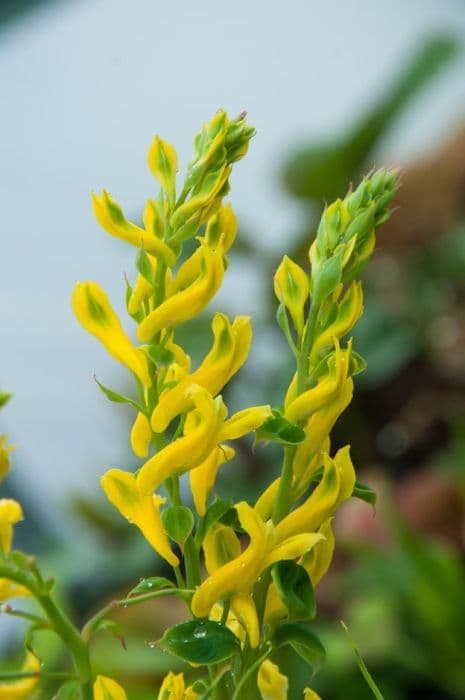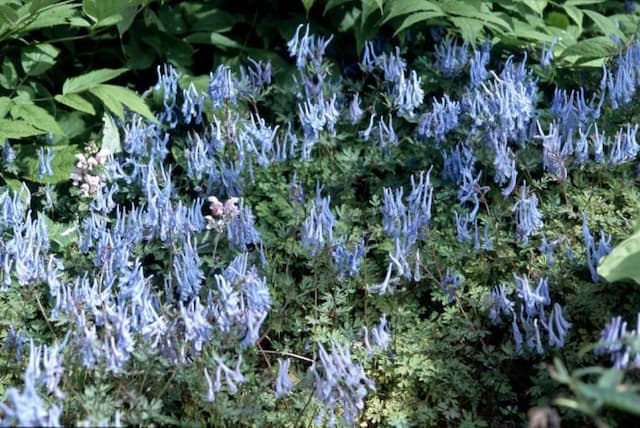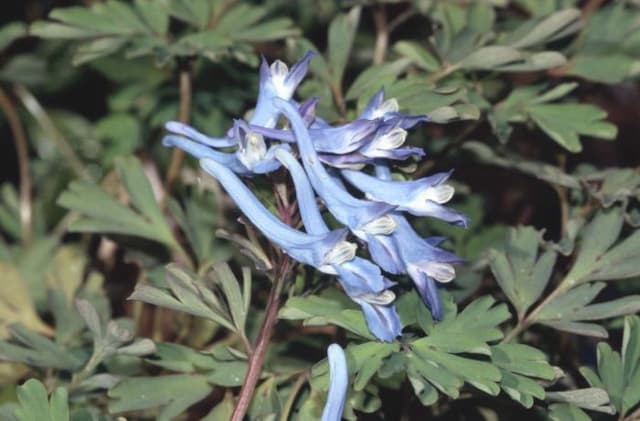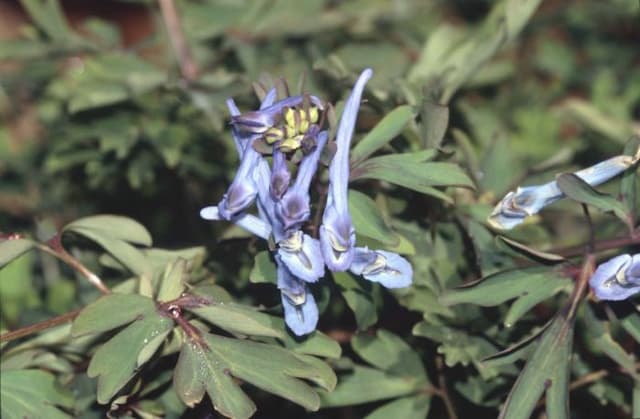Oriental Poppy Papaver (Oriental Group) 'Cedric Morris'
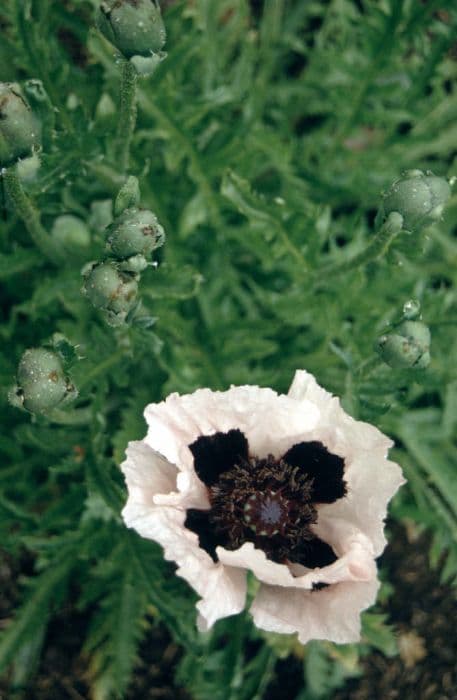
ABOUT
The Oriental Poppy 'Cedric Morris' boasts distinctive features with its large, showy flowers that are the main attraction. The blooms are characterized by their satiny petals that come in a soft, pastel pink hue, often with a touch of lavender. At the heart of each flower, there is typically a dark purple or black blotch that contrasts dramatically with the delicate petal color, adding an eye-catching quality to the plant. These flowers are further embellished by their frilly, ruffled edges, giving them a textured, ornamental look. The center of the flower features prominent stamens that surround a sizeable ovary, which is also a darker shade, often black or dark purple, creating a focal point that draws the eye. Oriental Poppy 'Cedric Morris' has a foliage that is also worth mentioning; the leaves are deeply cut and bristly in nature, providing an attractive feathery green backdrop that complements the floral display. Together, the elements of large, pastel-hued, ruffled flowers and deeply cut foliage give the Oriental Poppy 'Cedric Morris' a lush, exotic appearance that can provide a striking aesthetic in any garden setting where it blooms in late spring to early summer. However, after blooming, the foliage typically dies back, leaving the space to other plants to take center stage for the rest of the growing season.
About this plant
 Names
NamesSynonyms
Oriental Poppy, Perennial Poppy, Cedric Morris Poppy.
Common names
Papaver orientale 'Cedric Morris'.
 Toxicity
ToxicityTo humans
The plant in question is commonly known as the Oriental poppy 'Cedric Morris'. Oriental poppies can be toxic to humans if any part of the plant is ingested, as all parts contain alkaloids. The level of toxicity is generally considered low to moderate, but eating this plant can lead to symptoms such as nausea, vomiting, drowsiness, and in more severe cases, respiratory depression. It is advisable to avoid consuming any part of the Oriental poppy and to seek medical attention if ingestion occurs.
To pets
Oriental poppy 'Cedric Morris' possess a level of toxicity to pets as well, including both cats and dogs. Similar to humans, all parts of the Oriental poppy contain alkaloids which can cause poisoning if ingested. Symptoms in pets may include loss of appetite, sedation, disorientation, ataxia (loss of coordination), and in severe cases, respiratory depression or coma. If you suspect your pet has ingested any part of an Oriental poppy, contact your veterinarian immediately.
 Characteristics
CharacteristicsLife cycle
Perennials
Foliage type
Deciduous
Color of leaves
Green
Flower color
Pink
Height
2-3 feet (60-91 cm)
Spread
1-2 feet (30-60 cm)
Plant type
Herb
Hardiness zones
3-7
Native area
Caucasus Central Asia
Benefits
 General Benefits
General Benefits- Aesthetic Appeal: The Papaver cultivar 'Cedric Morris' is known for its bright and attractive flowers, which can enhance the visual appeal of a garden or landscape.
- Pollinator Attraction: These plants produce large, showy flowers that can attract pollinators such as bees and butterflies, contributing to the health of the local ecosystem.
- Drought Tolerance: Once established, poppies are known for their drought tolerance, making them suitable for gardens in drier climates or for water-wise landscaping.
- Low Maintenance: The Oriental poppy generally requires minimal care once established, making it an easy plant to maintain for gardeners of all skill levels.
- Seasonal Interest: Oriental poppies provide seasonal interest in late spring to early summer when they bloom, and their distinctive seed pods offer visual interest later in the season.
 Medical Properties
Medical PropertiesThis plant is not used for medical purposes.
 Air-purifying Qualities
Air-purifying QualitiesThis plant is not specifically known for air purifying qualities.
 Other Uses
Other Uses- Poppies can be used as a natural dye for fabrics and wool, with different parts of the plant producing a range of colors from green to yellow.
- The seeds of the poppy can be pressed to produce poppy seed oil, often utilized in art for oil painting as a carrier of pigments.
- Dried poppy pods and stems are popular in floral arrangements and crafts for their unique shapes and textures.
- In photography and botanical illustration, poppies are frequently used as subjects because of their vibrant colors and striking forms.
- Educational purposes such as studying pollination and plant life cycles are facilitated by poppies due to their distinct flower structure.
- Bake shops use poppy seeds obtained from some poppy varieties to add a nutty flavor and crunch to breads and pastries.
- Gardeners cultivate poppies to attract and sustain pollinators such as bees and butterflies, which are vital to ecosystem health and other nearby plants.
- The poppy's dried seed capsules can be used to create musical instruments for children, such as shakers or rattles.
- Poppies can act as companion plants in gardens, deterring pests away from vegetables and other flowers due to their strong scents and allelopathic properties.
- The stems of poppies, being hollow, can be used as rudimentary straws or channels in small-scale irrigation for gardening experiments.
Interesting Facts
 Feng Shui
Feng ShuiThe Oriental Poppy is not used in Feng Shui practice.
 Zodiac Sign Compitability
Zodiac Sign CompitabilityThe Oriental Poppy is not used in astrology practice.
 Plant Symbolism
Plant Symbolism- Remembrance: Papaver, commonly known as the Oriental Poppy, often symbolizes remembrance due to its association with commemoration of soldiers who have died in wars, particularly World War I.
- Peace: The Oriental Poppy is also a symbol of peace, with its bloom coinciding with Remembrance Day, and it embodies the hope for a peaceful future following conflict.
- Sleep and Rest: Because the poppy plant is a source of opium, which is used to make sedatives, it has come to represent sleep, rest, and oblivion.
- Beauty and Resilience: 'Cedric Morris' boasts beautiful and delicate flowers, symbolizing both the beauty of life and the resilience needed to bloom amidst the challenges.
- Death: In some traditions, poppies represent eternal sleep and death, likely because of their sedative properties and their blood-red color.
 Water
WaterThe Oriental Poppy 'Cedric Morris' prefers consistent moisture during the growing season, but it does not tolerate waterlogged soil. Water the poppies with about 1 inch of water per week, adjusting based on rainfall and soil type. It's best to water deeply and infrequently to encourage deep root growth. During hot, dry spells, increase watering slightly, but allow the soil to dry out between watering sessions. Over the winter, when the plant is dormant, reduce watering significantly.
 Light
LightOriental Poppies, such as 'Cedric Morris,' thrive in full sun. They require at least six hours of direct sunlight each day to ensure vigorous growth and bountiful blooms. The ideal spot for these plants is in an area where they can enjoy the morning sun, which is less intense, while still benefiting from the bright light throughout the day.
 Temperature
TemperatureOriental Poppies 'Cedric Morris' are cold-hardy and can tolerate winter temperatures down to about -30°F. They grow best in areas with cool winters and warm summers, preferring temperatures between 50°F and 75°F during their growing season. Extreme heat above 90°F can cause the plant to go dormant.
 Pruning
PruningOriental Poppy 'Cedric Morris' should be pruned to remove faded flowers, which encourages further blooming. Once the blooming season is over, usually in late spring or early summer, cut back the foliage to ground level to keep the garden tidy. Pruning is also essential after blooming to prevent self-seeding if you wish to control the spread of the plant.
 Cleaning
CleaningNot needed
 Soil
SoilThe Oriental Poppy 'Cedric Morris' prefers a well-drained soil that is rich in organic matter with a neutral to slightly alkaline pH between 6.5 and 7.5. A mix of loamy garden soil, compost, and perlite or sand can create an optimal growing environment.
 Repotting
RepottingOriental Poppies 'Cedric Morris' are generally not repotted often as they dislike having their roots disturbed. They are normally left in the same spot for several years unless the clump becomes too crowded.
 Humidity & Misting
Humidity & MistingOriental Poppy 'Cedric Morris' does well in average garden humidity levels and does not require any specific humidity adjustments as it is quite adaptable to outdoor conditions.
 Suitable locations
Suitable locationsIndoor
Provide bright light and cool temperatures indoors for the Oriental Poppy.
Outdoor
Plant in full sun, and well-drained soil; fertilize lightly in spring.
Hardiness zone
3-9 USDA
 Life cycle
Life cycleThe life cycle of the Oriental poppy 'Cedric Morris' begins with seed germination, which typically occurs in late winter or early spring when soil temperatures warm up. Seedlings emerge with a rosette of leaves at the soil surface. As temperatures continue to rise, the plant enters a vegetative growth phase, with the development of a sturdy stem and lobed leaves. By late spring or early summer, the plant produces distinctive large and vibrant flowers, which are often red, pink, orange, or white with a dark center. After pollination, the flowers fade and seed pods form, which eventually dry and release seeds for the next generation. As an herbaceous perennial, the Oriental poppy will die back to the ground at the end of the growing season, remaining dormant through the winter before resuming growth from its rootstock the following spring.
 Propogation
PropogationPropogation time
Early Spring
The Oriental poppy 'Cedric Morris' is typically propagated by seed. To propagate by seed, sow the seeds thinly in a cold frame or directly outdoors in early spring or fall. In regions with mild winters, sowing in fall allows for a natural stratification process, as these seeds need a period of cold to break their dormancy. When planted in spring, artificially stratifying the seeds by placing them in a refrigerator for a few weeks before sowing can improve germination rates. Once the seedlings have developed true leaves and are large enough to handle, they can be transplanted into their final position, ensuring they are set at the same depth they were growing at previously. Oriental poppy 'Cedric Morris' prefers a position in full sun with well-drained soil.
